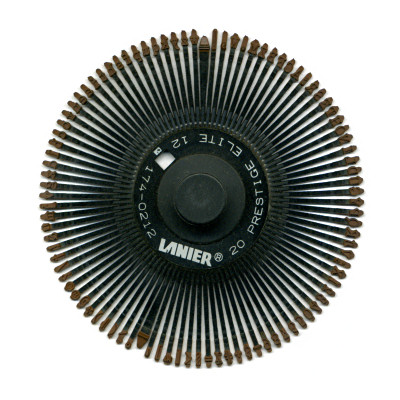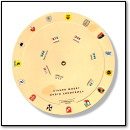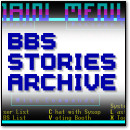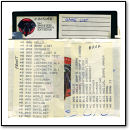[ Retro Scan of the Week ] The Daisy Wheel
October 24th, 2011 by Benj EdwardsHere’s an interesting piece of obsolete technology — a plastic Lanier daisy wheel for a daisy wheel printer. Its actual size is about three inches in diameter.
There was a time when having a “letter quality” impact printer meant that the machine printed text using pre-formed, typewriter-like type elements. Some printers held these elements in the shape of a cylinder or a sphere, but in the case of the daisy wheel printer, the character forms projected from a central wheel in a shape that resembled a daisy flower.
Daisy wheel printers produced text by rotating the wheel to the proper character spoke and striking the back of it against an ink ribbon, which would leave a mark on the underlying paper.
Each daisy wheel rendered a different font (or type size), and thus fonts could be changed as easily as replacing one wheel with another. In this case, you’re looking at a wheel for the font called “Prestige Elite 12,” but printer makers sold dozens of other font wheels, such as those for Courier 10 or Cubic 15.
The daisy wheel method reproduced fonts using a dramatically different technique than, say, dot-matrix printers, which used a single matrix of metal pins to form various characters.
Laser and inkjet printers, which produce much less noise and use software-based fonts, made impact printers thoroughly obsolete for every-day PC use by the late 1980s (though stragglers used dot-matrix printers well into the mid-1990s due to lower prices). Even so, impact printers still reign supreme in specialized applications that require physical force, such as document reproduction via carbon copy paper.
Discussion Topic of the Week: Have you ever used a daisy wheel printer? Tell us about it.







October 24th, 2011 at 1:12 pm
I ended up buying some horrible all-in-one word processor unit around 1995 that had a built in daisy wheel printer. It also had a text only cathode-ray monitor and a floppy drive that would save to a proprietary format that took forever to load.
I was living in an apartment at the time, and the thing was so loud that I always waited for the people downstairs to head out before I’d print anything.
I ended up giving it to my sister, who used it all through high school until she graduated in 1998. I think it’s still sitting in the attic of my mother’s house, alongside my 1980 IBM PC.
October 24th, 2011 at 3:24 pm
My first home computer was a Coleco Adam, with its notorious (and gigantic) daisy wheel printer. The printer contained the computer’s power supply and therefore must always be connected to the computer.
The machine had a fairly decent word processor in ROM (instead of BASIC) and would initially startup in simple typewriter mode where keystrokes are sent immediately to the printer.
As great as it was to have a real letter quality printer, it was incredibly slow and noisy, and I really missed the ability to print multiple fonts and graphics.
October 24th, 2011 at 4:31 pm
Graphics killed the daisy wheel printer. Literally. Sometime in the pre-Excel days (when people used Visicalc or Lotus 123 or one of the other -calcs) someone figured out that you could still print graphs using a daisy wheel printer if you used the period “.” for the data points and used microspacing to get better resolution. The end result was passable graphs, but inevitably it would bang the period flat after a while since about 1000 times more periods were being printed than they ever expected. You could tell when this happened because all the documents printed after that contained no periods, or at best, very fat faint ones.
October 24th, 2011 at 6:58 pm
Great story, K4DSP. Those kinds of tales are why I started this blog.
And Stan, I have a full Adam system, and the built-in word processor is pretty cool, isn’t it? It’s a very cumbersome setup, but it works surprisingly well for an almost toy computer of that era. I really like Adam’s keyboard too. Pretty good layout and a good feel.
October 25th, 2011 at 1:33 pm
By the way, if anyone out there has an old brother letter quality printer for sale, please let me know. I need one. Email synchead@verizon.net
October 25th, 2011 at 2:01 pm
K4DSP, back in the mid-80’s one of our school’s printers had a second wheel just for graphing. The period on the second wheel was made out of thicker (and presumably stronger) metal. The wheel also had “special” ASCII character sets.
October 26th, 2011 at 5:51 am
this kind of printer is perfect for ASCII Art, especially with the wheels mentiond by Geoff V.
never use this type of printer, but i can imagine printing a lot of pages with this machine will make a sound like you have an incredible secretary using a typewriter!! TACK TACK TACK TACK!!!!
October 27th, 2011 at 11:42 am
Hi, I’m Daisy
November 21st, 2011 at 5:33 pm
Topic resurrection!
I have an old Tandy daisy wheel printer that was in storage at my mom’s house that I just retrieved a few days ago. It’s a little dirty, but when I fed it some paper and hit the “Test” switch it trundled to life. It took about three lines of blank printing before it got past the part of the ribbon that had been exposed to the environment for 10+ years, at which point it started churning out its entire character set in black. Next up is to hook it up to a computer (if I can find a parallel printer cable) and make sure it’s otherwise operational before I start to clean it up. Then… umm… I don’t know what I’ll do with it then.
November 22nd, 2011 at 7:27 pm
This reminds me, I have a Commodore DPS-1101 somewhere, I’d love to get that thing working again. Scary as hell when it got into its full stride, clanking away and probably hitting 1 or 2 on the Richter Scale.
Might try and hook it up to my C128D and see if it’s still alive.
November 24th, 2011 at 1:15 pm
I have a smith-corona word processor that has a built-in daisy wheel printer. It has an lcd screen, decent keyboard, and a floppy drive that it saves stuff to in (I think) a regular plaintext format. Quite nice, and not very loud.